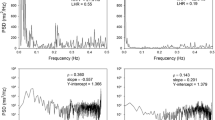Abstract
Background
Power spectral analysis of heart rate variability is used to assess cardiac autonomic function. The relationship of low frequency (LF) power to cardiac sympathetic tone has been unclear. We reported previously that LF power may reflect baroreflex modulation. In this study we attempted to replicate our findings in additional subject cohorts, taking into account possible influences of respiration and using different methods to measure baroreflex-cardiovagal gain (BCG).
Objective
We assessed relationships of LF power, including respiration-adjusted LF power (LFa), with cardiac sympathetic innervation and baroreflex function in subjects with or without neuroimaging evidence of cardiac sympathetic denervation.
Methods
Values for LF power at baseline supine, seated, and during the Valsalva maneuver were compared between subject groups with low or normal myocardial concentrations of 6-[18F]fluorodopamine-derived radioactivity. BCG was calculated from the slope of cardiac interbeat interval vs. systolic pressure during Phase II of the Valsalva maneuver or after i.v. nitroglycerine injection (the Oxford technique).
Results
LF and LFa were unrelated to myocardial 6-[18F]fluorodopamine-derived radioactivity. During sitting rest and the Valsalva maneuver logs of LF and LFa correlated positively with the log of Phase II BCG (r = 0.61, p = 0.0005; r = 0.47, p = 0.009; r = 0.69, p < 0.0001; r = 0.60, p = 0.0006). Groups with Low BCG (≤3 ms/mmHg) had low LF and LFa regardless of cardiac innervation. The log of LF power during supine rest correlated with the log of Oxford BCG (r = 0.74, p < 0.0001).
Conclusion
LF power, with or without respiratory adjustment, reflects baroreflex modulation and not cardiac sympathetic tone.





Similar content being viewed by others
Abbreviations
- BCG:
-
Baroreflex-cardiovagal gain
- HF:
-
High frequency
- HFa:
-
Adjusted high frequency power
- LF:
-
Low frequency
- LFa:
-
Adjusted low frequency power
References
Akselrod S, Gordon D, Ubel FA, Shannon DC, Berger AC, Cohen RJ (1981) Power spectrum analysis of heart rate fluctuation: a quantitative probe of beat-to-beat cardiovascular control. Science 213:220–222
Alvarenga ME, Richards JC, Lambert G, Esler MD (2006) Psychophysiological mechanisms in panic disorder: a correlative analysis of noradrenaline spillover, neuronal noradrenaline reuptake, power spectral analysis of heart rate variability, and psychological variables. Psychosom Med 68:8–16
Aysin B, Aysin E (2006) Effect of respiration in heart rate variability (HRV) analysis. Conf Proc IEEE Eng Med Biol Soc 1:1776–1779
Baumert M, Lambert GW, Dawood T, Lambert EA, Esler MD, McGrane M, Barton D, Sanders P, Nalivaiko E (2009) Short-term heart rate variability and cardiac norepinephrine spillover in patients with depression and panic disorder. Am J Physiol Heart Circ Physiol 297:H674–H679
Creager MA (1992) Baroreceptor reflex function in congestive heart failure. Am J Cardiol 69:10G–15G discussion 15G-16G
Eisenhofer G, Friberg P, Rundqvist B, Quyyumi AA, Lambert G, Kaye DM, Kopin IJ, Goldstein DS, Esler MD (1996) Cardiac sympathetic nerve function in congestive heart failure. Circulation 93:1667–1676
Goldstein DS (2001) The autonomic nervous system in health and disease. Marcel Dekker, New York
Goldstein DS (2003) Dysautonomia in Parkinson’s disease: neurocardiological abnormalities. Lancet Neurol 2:669–676
Goldstein DS, Eisenhofer G, Dunn BB, Armando I, Lenders J, Grossman E, Holmes C, Kirk KL, Bacharach S, Adams R et al (1993) Positron emission tomographic imaging of cardiac sympathetic innervation using 6-[18F]fluorodopamine: initial findings in humans. J Am Coll Cardiol 22:1961–1971
Goldstein DS, Holmes C, Li ST, Bruce S, Metman LV, Cannon RO 3rd (2000) Cardiac sympathetic denervation in Parkinson disease. Ann Intern Med 133:338–347
Goldstein DS, Horwitz D, Keiser HR (1982) Comparison of techniques for measuring baroreflex sensitivity in man. Circulation 66:432–439
Goldstein DS, Orimo S (2009) Cardiac sympathetic neuroimaging: summary of the First International Symposium. Clin Auton Res 19:133–136
Goldstein DS, Pechnik S, Holmes C, Eldadah B, Sharabi Y (2003) Association between supine hypertension and orthostatic hypotension in autonomic failure. Hypertension 42:136–142
Goldstein DS, Tack C (2000) Non-invasive detection of sympathetic neurocirculatory failure. Clin Auton Res 10:285–291
Haensch CA, Lerch H, Jorg J, Isenmann S (2009) Cardiac denervation occurs independent of orthostatic hypotension and impaired heart rate variability in Parkinson’s disease. Parkinsonism Relat Disord 15:134–137
Kaufmann H (1996) Consensus statement on the definition of orthostatic hypotension, pure autonomic failure and multiple system atrophy. Clin Auton Res 6:125–126
Kingwell BA, Thompson JM, Kaye DM, McPherson GA, Jennings GL, Esler MD (1994) Heart rate spectral analysis, cardiac norepinephrine spillover, and muscle sympathetic nerve activity during human sympathetic nervous activation and failure. Circulation 90:234–240
Moak JP, Goldstein DS, Eldadah BA, Saleem A, Holmes C, Pechnik S, Sharabi Y (2007) Supine low-frequency power of heart rate variability reflects baroreflex function, not cardiac sympathetic innervation. Heart Rhythm 4:1523–1529
Ng J, Sundaram S, Kadish AH, Goldberger JJ (2009) Autonomic effects on the spectral analysis of heart rate variability after exercise. Am J Physiol Heart Circ Physiol 297:H1421–H1428
Orimo S, Oka T, Miura H, Tsuchiya K, Mori F, Wakabayashi K, Nagao T, Yokochi M (2002) Sympathetic cardiac denervation in Parkinson’s disease and pure autonomic failure but not in multiple system atrophy. J Neurol Neurosurg Psychiatry 73:776–777
Pickering TG, Sleight P (1969) Quantitative index of baroreflex activity in normal and hypertensive subjects using Valsalva’s manoeuvre. Br Heart J 31:392
Sleight P, La Rovere MT, Mortara A, Pinna G, Maestri R, Leuzzi S, Bianchini B, Tavazzi L, Bernardi L (1995) Physiology and pathophysiology of heart rate and blood pressure variability in humans: is power spectral analysis largely an index of baroreflex gain? Clin Sci (Lond) 88:103–109
Acknowledgments
This research was supported by the Intramural Research Program of the NIH, National Institute of Neurological Disorders and Stroke. Ms. Tereza Jenkins coordinated patient travel. Division of Intramural Research, NINDS, NIH. The authors have no conflicts of interest to disclose.
Author information
Authors and Affiliations
Corresponding author
Rights and permissions
About this article
Cite this article
Rahman, F., Pechnik, S., Gross, D. et al. Low frequency power of heart rate variability reflects baroreflex function, not cardiac sympathetic innervation. Clin Auton Res 21, 133–141 (2011). https://doi.org/10.1007/s10286-010-0098-y
Received:
Accepted:
Published:
Issue Date:
DOI: https://doi.org/10.1007/s10286-010-0098-y




